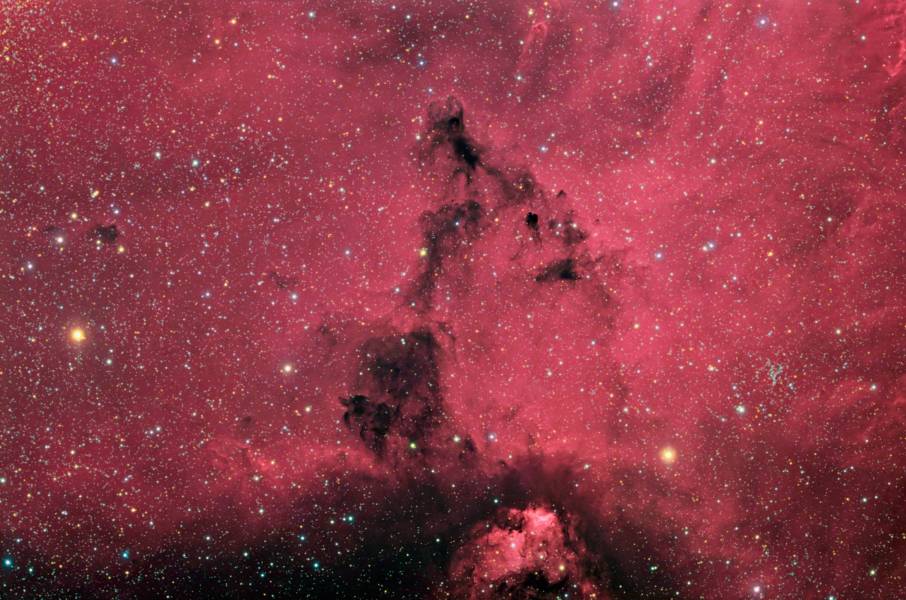The "Philippine Nebula" |
 |
| This image focuses on a complex of dark nebulae (near the Cone Nebula)
centered (according to astrometric plate solves at epoch J2000) at RA 06h 37m
18s, Dec 10d 24m 18s. As we Earth-based gazers stare up at the heavens, we oftentimes relate the various objects we see to familiar-looking terrestrial objects or themes in our efforts to describe what we are seeing either through the eyepiece or on photographic plates or digital images. We name some objects based on their resemblance to familiar objects. Names such as the Rosette Nebula, the Running Man, the Christmas tree cluster, and the Pelican Nebula come to mind, not to mention famous familiar shapes like the Horsehead Nebula. Some objects are named differently based by different cultures. A famous (at least to me) example is Carl Sagan's presentation on Cosmos of how the Big Dipper asterism is referred to as the Plowshare in old England and (pretty creatively) as a bureaucrat being petititioned by the ancient Chinese. There are some objects that have been given geographic monikers by obvious resemblances - the North America nebula comes to mind. As I look upon images posted by other astro-imagers, I often find myself playing that Rorshackian game of "what do you see?" Not unlike children lying in a field idly calling out what they see in clouds overhead, I ask myself to connect the dots in star clusters or find a shape in a nebula. I'd like to present an image that invokes a geographic moniker influenced by a cultural view. There is a dark nebulosity in Monoceros not too far from the Cone Nebula/Fox Fur region. I was not aware of this nebula myself until around 2004 or 2005, when I was admiring an extreme wide-field narrow-band image of the region by a fellow imager. I resolved to shoot this interesting (at least to me) target, and did so in Hydrogen-Alpha in 2006. Now, six years later, I am finally able to present it in full color! It is an often-overlooked nebula, overshadowed by the nearby more popular Cone and FoxFur nebula. It ofen shows up in images of the region, but is usually presented as an afterthought. I believe it is a part of the B36-37-38 dark nebulosity in Monoceros. It may have already been named, but if so I am not aware of any. I thought I'd showcase this nebula as the subject of interest instead as a tribute to my geo-cultural origin. Without further ado, may I present to you all what I call the "Philippine Nebula" complex. Not an official name by any account <G> The cluster of stars to the lower right is NGC 2259. |
| Constellation: Monoceros |
| When Visible: January - April |
| Distance: |
| Date: January 2012 |
| Location: Rancho Hidalgo, Animas, NM |
| Exposure Details:
H-Alpha: 19 x 30 Minutes Binned 1x1 Red: 15 x 10 Minutes Binned 1x1 Green: 15 x 10 Minutes Binned 1x1 Blue: 15 x 10 Minutes Binned 1x1 17 Hours Total Exposure Time |
| Equipment Used: Takahashi TOA-130F on an Astro-Physics AP1200GTO mount. SBIG STL-6303E camera with FW8-STL filter wheel and Astrodon LRGB and narrowband filters. Robofocus focuser and Astrodon Takometer rotator. |
| Acquisition Software : MaximDL 5, TheSky6, CCDAutopilot 5, FocusMax, Takometer Controller |
| Processing Software: MaximDL, Photoshop CS/CS5, Carboni Actions, IrFanView |
| An earlier version shot with a Takahashi FS-102 refractor at f/6 on a Takahashi EM200 Temma-PC mount, SBIG STL-6303 camera and Astrodon H-alpha filter can be found here. |
